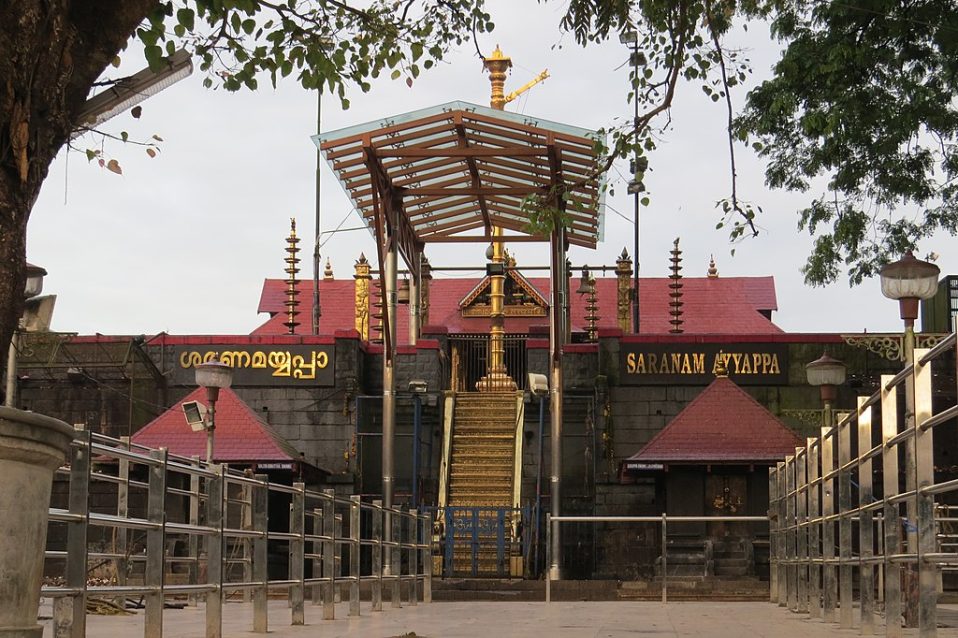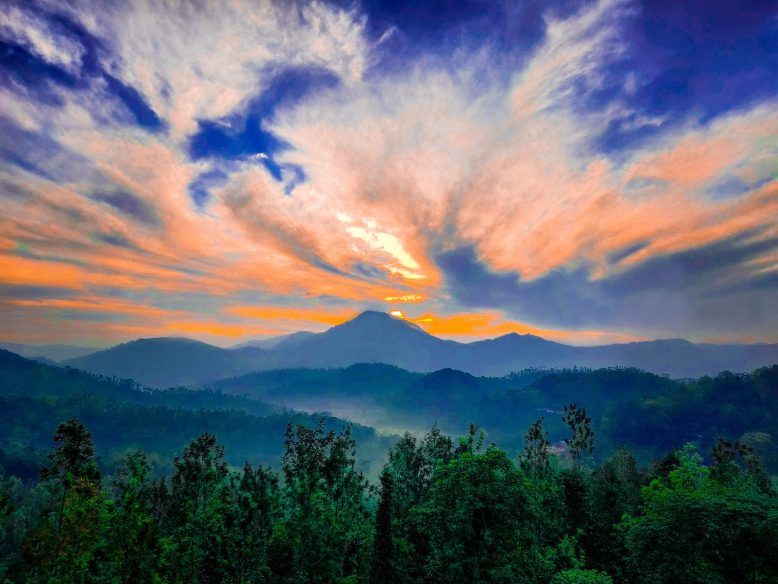Once upon a time, there were sixteen primordial tribes who lived with their creator in their heavenly abode, the kingdom of clouds. One day, a curious man among them gazed down and discovered a lush paradise, a land adorned with mesmerizing waterfalls, verdant jungles, and abundant food. He asked the creator to conceive the jingkiengjriksiar, a mythical “golden bridge” made from the branches of a majestic tree, connecting the two worlds. With this bridge, some of the tribes moved into this idyllic land.
No, this isn’t an excerpt from Lord of the Rings or the Hobbit. It’s the kind of tale Jambor Massar heard while growing up in northeastern India, huddled with his siblings around the fire on long, cold nights. It’s also the story he shared with me as I stood on the edge of something I’d never seen before—the most incredible bridge, woven from living roots, stretching across the forest floor. Now I’ve heard a lot about the root bridges of Meghalaya and I was dying to walk over it. So after an uncomplicated cab ride from Shillong, I met Jambor, a middle-aged Khasi man who offered to guide me. As I prepared to mightily step onto the gnarled, twisted roots that formed the bridge, I paused and asked, “What’s so special about this?” Jambor smiled, his eyes gleaming with the knowledge of generations, and said, “Careful, it’s living.”
And so begins the story of the living root bridges—a living legacy, where roots hold more than just the earth—they carry a timeless bond between people, nature, and the future.
The living bridges of Meghalaya – Nature’s engineering marvels
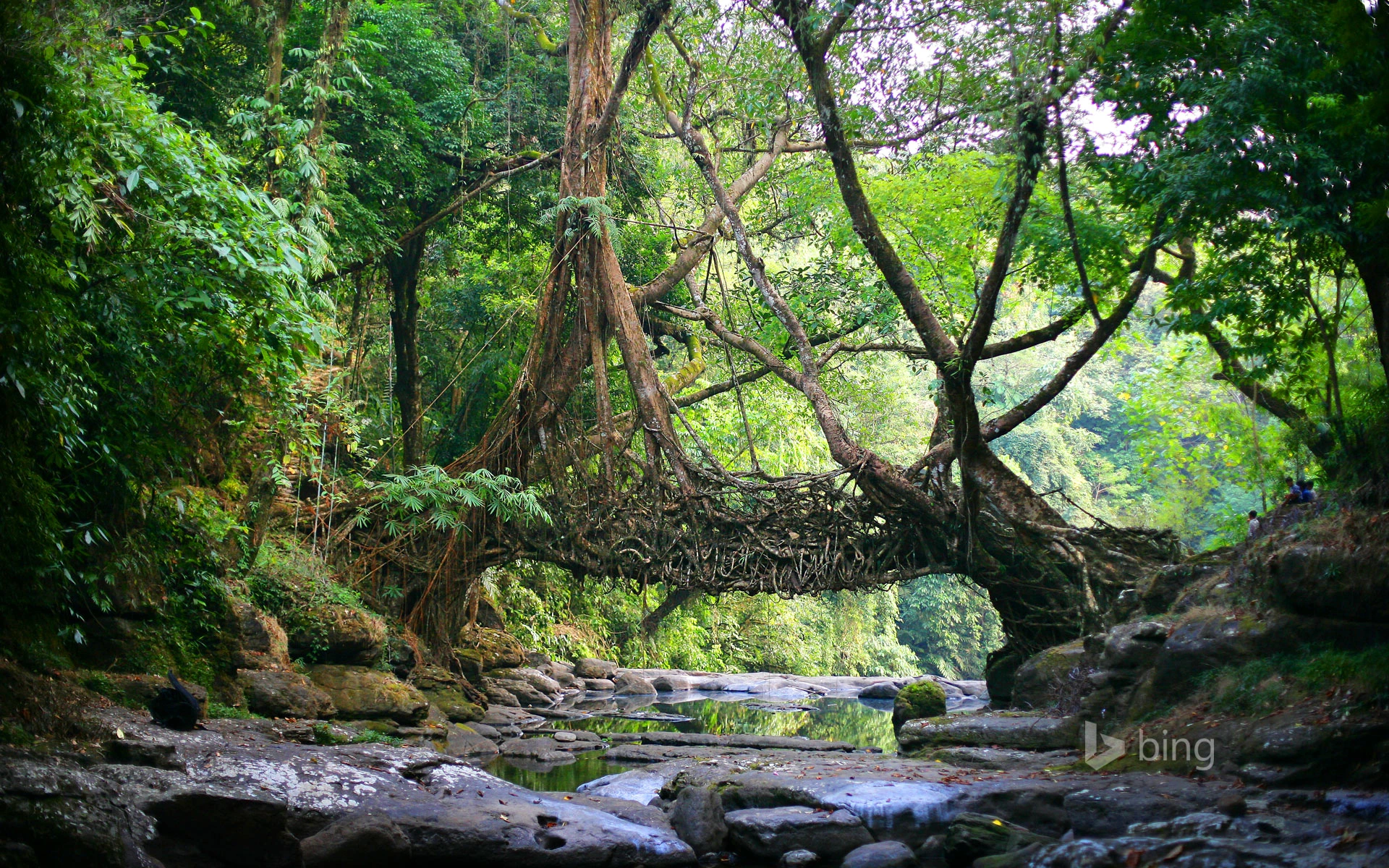
In a world dominated by concrete and steel, man and nature often find themselves at odds—whether in the form of sprawling cities encroaching on lush forests or rivers diverted for human needs. But in Meghalaya, this conflict is defied —a place where the bond between humans and nature flourishes in quiet strength. Here, the bridges aren’t built from iron or stone, but from the very roots of trees, shaped by human hands over generations. Just as the wind shapes dunes and rivers carve canyons, nature here has built bridges.
Living root bridges are remarkable pedestrian pathways made from the roots of living trees. These natural wonders not only provide access to remote areas but also serve as lifelines for the Khasi tribes, allowing them to gather essential resources like wood and water for survival. Jambor Massar shares, “It rains here throughout the year, so the streams are always full of water. It is nearly impossible to swim or wade through them, especially if one is traveling with family or carrying heavy goods. That is why these bridges are so important.”
With over 75 recorded living root bridge structures across their areas, each living bridge structure is site-specific – the rivers, gorges and valleys along with climatic differences make every living root bridge extremely unique in form and function within its ecosystems. Each bridge represents a careful collaboration between humans and nature. The process begins with the roots of the Ficus Elastica tree, which are placed in hollowed-out trunks of the Areca Catechu palm. These trunks nourish and protect the roots, guiding their growth with the help of a bamboo framework.
Bridges that grow – The Khasi people’s legacy of living pathways
In the Khasi hills, this indigenous tribe has mastered the art of creating bridges from the roots of ficus trees, a skill refined over centuries. Villagers carefully guide the aerial roots of the Ficus Elastica tree across rivers using bamboo scaffolding, tying the roots at both ends so they grow toward each other and gradually intertwine. This is no quick process—it takes 20 to 25 years for the roots to fully mature into self-sustaining structures. These natural bridges allow safe passage through the dense forests and deep valleys of the East Khasi Hills, where heavy rainfall and frequent landslides make modern concrete and steel bridges unfeasible. Stones, timber planks, leaves, and soil are added to fill gaps and provide additional strength and stability.
“I was about eight years old when my grandfather showed me a living root bridge that he was growing across the Ummunoi river,” Jambor shared, his eyes lighting up with memory. “Grandfather intertwined the lessons with stories from Khasi oral tradition, a fundamental tool our people use to teach children about the environment and the laws of nature. While tales like the tragic story of Nohkalikai Falls were often told, Khasi oral traditions go far beyond storytelling—they’re a way of teaching life’s deeper lessons.”
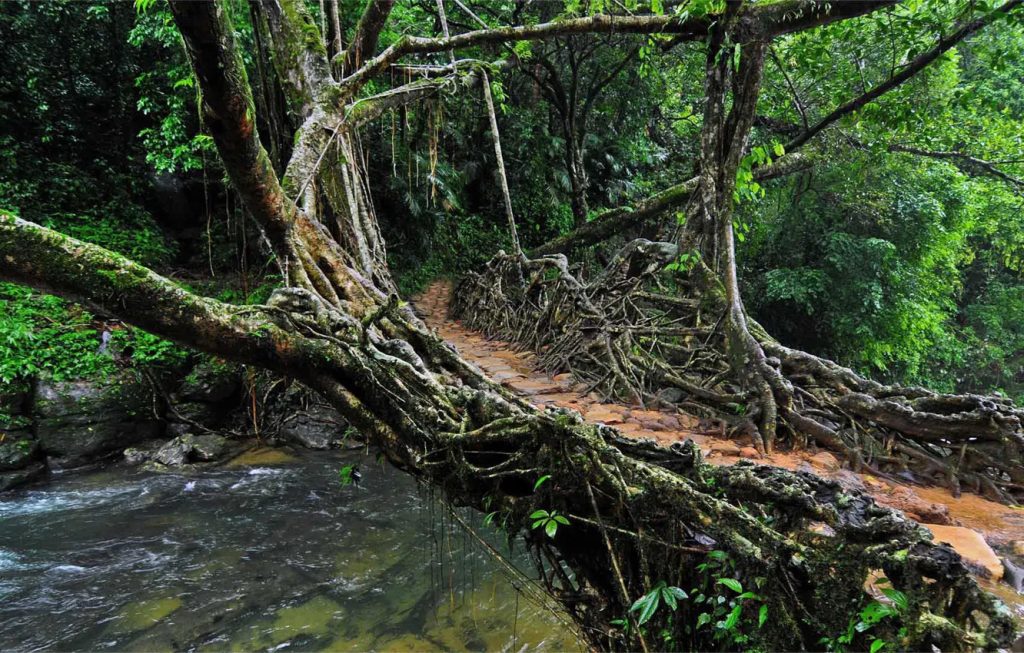
The oral tradition meant that there were no written formulas or documentation on the science of making bridges—it was a skill, a craft, an art, a behavior pattern, and an experience passed on from one generation to another.” But these bridges aren’t just solutions for today. Just like flora, they’re designed to grow stronger over time, serving the future generations of the Khasi people, who continue to nurture them just as their ancestors did.
Notable Living Root Bridges of Meghalaya
Meghalaya is home to over a hundred living root bridges, each offering a unique glimpse into the region’s natural and cultural heritage. Below are some of the most well-known examples, though it’s important to note that the exact length and age of these bridges can vary, as records aren’t always consistently kept.
Umshiang Double-Decker Living Root Bridge – Two-tiered marvel in Nongriat
Spanning about 30 meters, the Double-Decker Root Bridge in Nongriat is one of the most iconic natural wonders of Meghalaya. Situated 2,400 feet down a steep valley, the trek involves descending roughly 3,500 steps, starting from the village of Tyrna, which is located about 13 km from Sohra (Cherrapunjee). Believed to be over 250 years old, this unique bridge consists of two levels of intertwined roots.
Originally, there was a single-root bridge crossing the Umshiang River, but heavy monsoon rains frequently submerged it. To solve this problem, a second, higher bridge was built above the original, creating the remarkable double-decker structure we see today. After reaching Nongriat, visitors can continue trekking for about an hour to reach the beautiful Rainbow Falls, a natural pool with crystal-clear water. Additionally, you can explore the scenic beauty of Cherrapunji after visiting this remarkable root bridge.
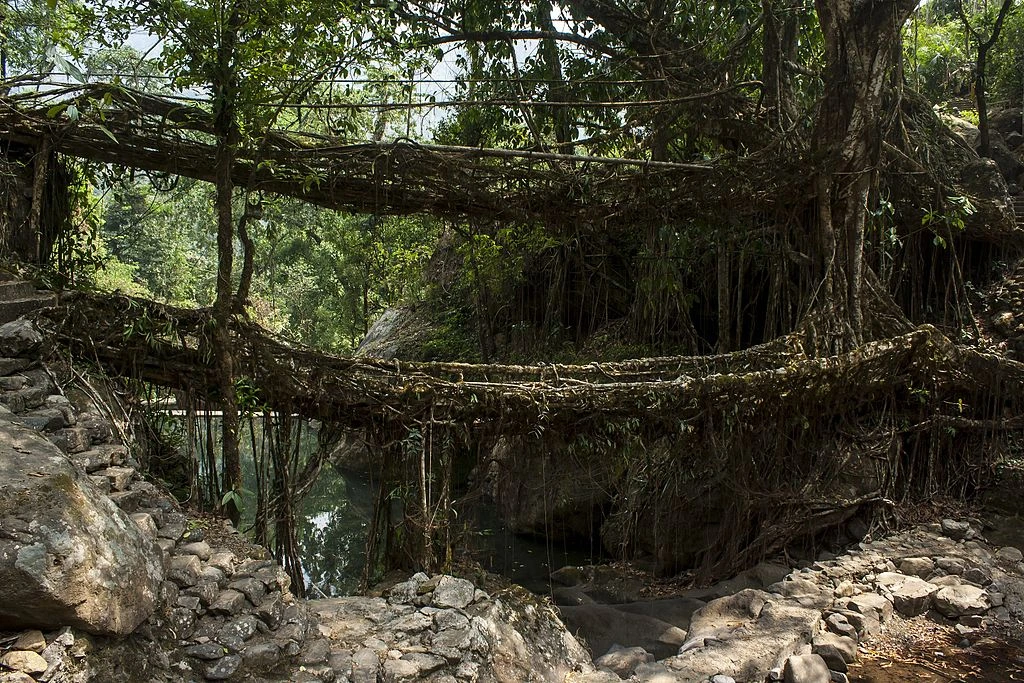
Riwai single-level root bridge – A thick and wide wonder in Mawlynnong
Mawlynnong, a small village in Meghalaya’s East Khasi Hills District, gained fame in 2003 when it was named the cleanest village in Asia. Often referred to as “God’s Own Garden” due to its pristine beauty and warm community, it’s home to another popular attraction— a single-level living root bridge located in Riwai Village, about 80 km from Meghalaya’s capital. The bridge is easily accessible with a short 300-meter hike through the rainforest, making it a more convenient option for those who may not want to embark on the challenging trek to Nongriat. Thicker and wider than the Double-Decker Root Bridge, this bridge spans a stream amidst lush greenery, offering a peaceful and scenic
Rangthylliang – The highest living root bridge in Meghalaya
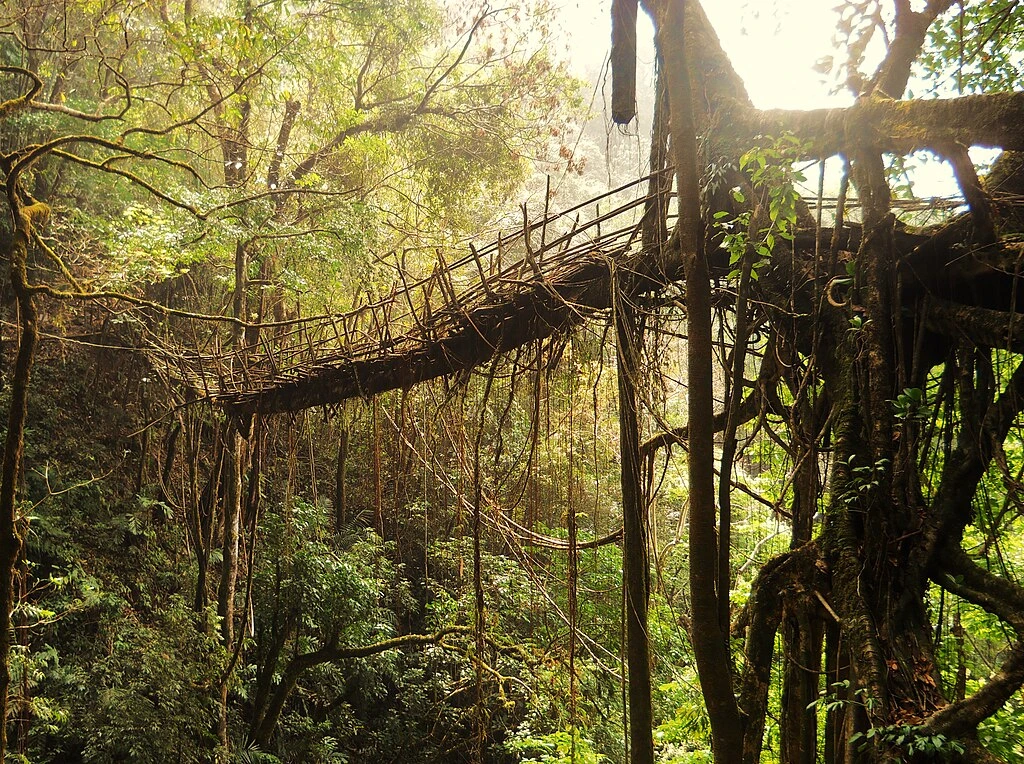
Rangthylliang is not only home to some of the densest forests in Meghalaya but also houses the highest living root bridge in the state. Hidden among ancient trails that were once used for trade, Rangthylliang has around a hundred living root bridges scattered throughout the region. A large community of skilled living root bridge architects resides in the area, ensuring that this tradition continues to thrive.
Kongthong – The steepest and most unusual living root bridge
In Kongthong, the living root bridge is so steep that it almost resembles a natural ramp rather than a conventional bridge. The origin of this unique arrangement of roots is difficult to determine, but it’s clear that the tree has been growing for centuries. Some of the roots are several feet in diameter, indicating that they have been in position for a very long time. The bridge has distinctive features, such as roots carved into steps and others trained sideways to form ladder-like rungs. This unusual structure also includes newer sections where roots have been guided from the tree to the riverbank, possibly due to shifts in the river’s course over time.
Kudeng Rim – A living root bridge with a dramatic waterfall view
The living root bridge at Kudeng Rim 5 stands out due to its dramatic location, perched over the Amkshar River at a height of over 19 meters. Spanning a sheer-walled canyon and framing a waterfall when viewed from downstream, the bridge is one of the most picturesque in all of Meghalaya. Though it boasts the 4th tallest measured height of any living root bridge, its future is uncertain due to signs of decay. Large sections of the tree are rotting, and the structure appears to have thinned out in recent years, making it increasingly fragile.
Mawshuit – A precarious and abandoned bridge
Mawshuit 1 is an abandoned root bridge located above the Myor River, now critically threatened by environmental factors. Its impressive height and dramatic setting make it noteworthy, but much of the nearby jungle has been destroyed in shifting cultivation fires, leaving the area barren and vulnerable. The structure is deteriorating rapidly, and with a newly constructed road bypassing the bridge, locals no longer have a reason to maintain it. Sadly, the unmaintained bridge has become too dangerous to cross, and its days may be numbered.
Thangkyrta 2 – A forgotten bridge of immense scale
Thangkyrta 2 is perhaps one of the most unusual living root bridges I’ve come across. What makes it truly remarkable is the sheer size of the tree from which it is formed. The bridge is said to have been created by a village that no longer exists, having divided into several smaller settlements sometime before the turn of the 20th century. The village may be gone, but the massive bridge remains, a silent testament to the craftsmanship of a forgotten community. Today, it stands as an awe-inspiring reminder of the deep connection between nature and human ingenuity.
Longest Living Root Bridge in Meghalaya – Mawkyrnot
The longest living root bridge in Meghalaya is located in Mawkyrnot, in the East Khasi Hills district. Spanning a remarkable 53 meters (174 feet), this bridge is a prime example of the Khasi people’s ingenuity. Carefully intertwined aerial roots of rubber trees form this durable structure, which has connected villages for centuries, particularly during the challenging monsoon season.
Rittymmen Root Bridge – A rooted wonder in Nongthymmai
Situated in Nongthymmai village, the Rittymmen Root Bridge is known for its impressive structure, formed by ancient interconnecting roots. Located just 45 km from Shillong, this single-decker bridge is easily accessible and remains a popular attraction for its beauty and ease of access.
Ummunoi Root Bridge – A serene escape in Dawki
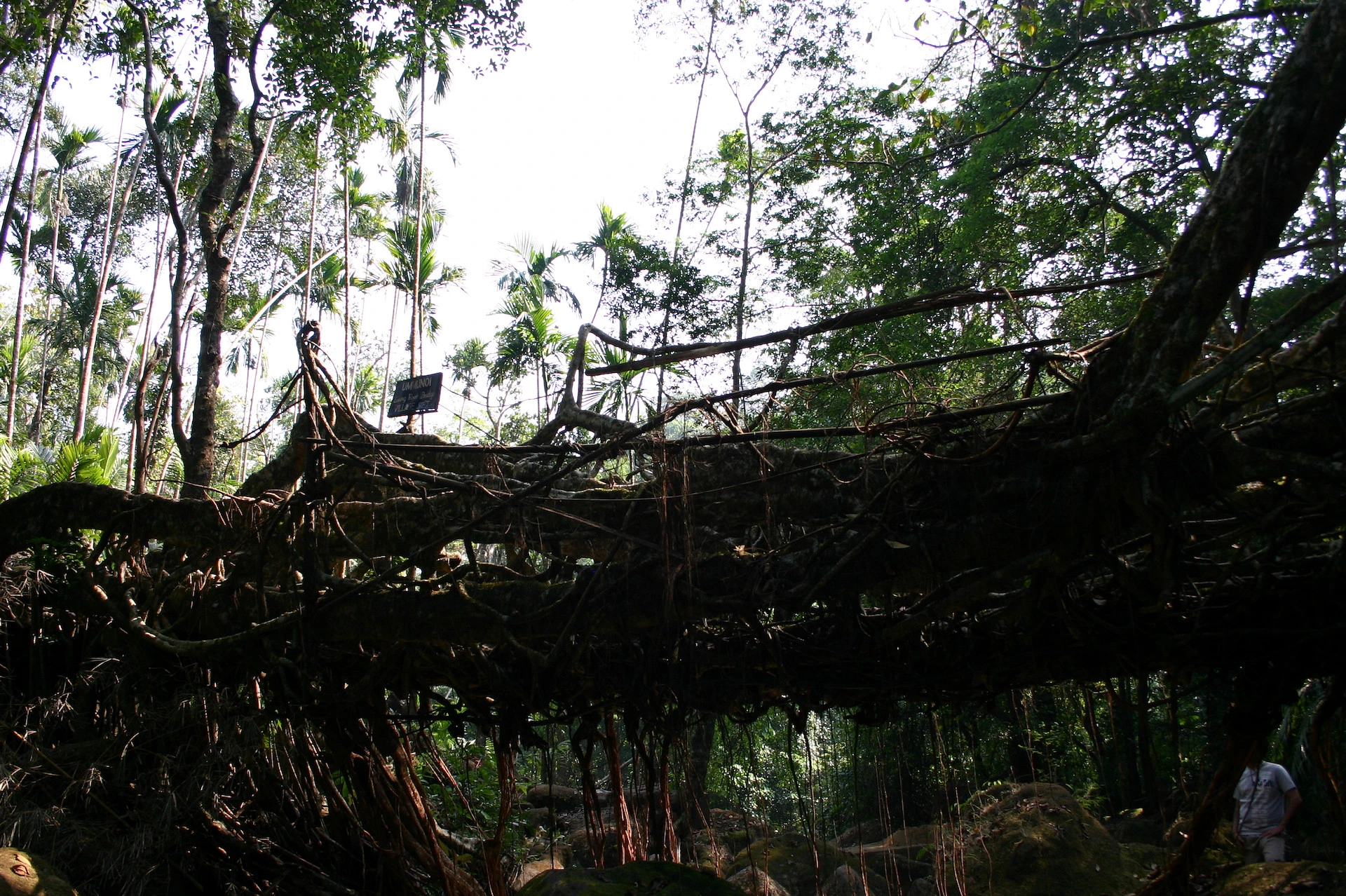
The Ummunoi Root Bridge, found near the village of Umkar, close to Dawki, is known for its simplicity and natural beauty. Dawki, Duki or Dauki is a picturesque town in the district of West Jaintia Hills in Meghalaya, snuggled between the borders of India and Bangladesh. Visitors can drive approximately 82 km from Shillong to Dawki before reaching this peaceful single-decker bridge. Its proximity to the more famous Dawki Living Root Bridge makes it a convenient and serene addition to any itinerary.
Umkar Root Bridge – Strength and durability in Umkar Village
The Umkar Root Bridge, located near the Ummunoi Bridge in the same village, is another impressive structure known for its strength. Following the same route from Shillong to Dawki, visitors can witness this sturdy root bridge, which has provided stability and connectivity to the local villages for generations.
Living Root Bridge at Shnongpdeng – Picturesque and adventure-filled
Near the village of Shnongpdeng, the Living Root Bridge offers a stunning view of the riverside and serves as a gateway to the area’s adventure activities. Approximately 95 km from Shillong, this single-decker bridge is easily reached after a short walk from the village, making it a perfect stop for those seeking both beauty and thrill.
Padu Bridge – A hidden gem near Mawlynnong
Located in Padu village, near Mawlynnong, this single-decker root bridge provides visitors with a tranquil experience. A short drive from Mawlynnong village brings you to this lesser-known bridge, which showcases the region’s commitment to natural and sustainable construction.
Nongbareh Living Root Bridge – A masterpiece near Mawlynnong
The Nongbareh Living Root Bridge is another impressive structure near Mawlynnong, created using the age-old techniques of the Khasi people. Easily accessible after a drive from Shillong, this single-decker bridge offers a glimpse into the sustainable practices of the region, with roots intertwined to form a sturdy passage.
With each of these remarkable living root bridges, you’ll experience the ingenuity of the Khasi people and their deep-rooted connection to nature. You can also explore the plethora of waterfalls you can find in Meghalaya, each more majestic than the next. The rugged terrains can be challenging, but with Savaari’s experienced chauffeurs, you’ll have the expertise needed to navigate through these scenic landscapes while ensuring a safe and comfortable journey.
Remarkable features that set living root bridges apart
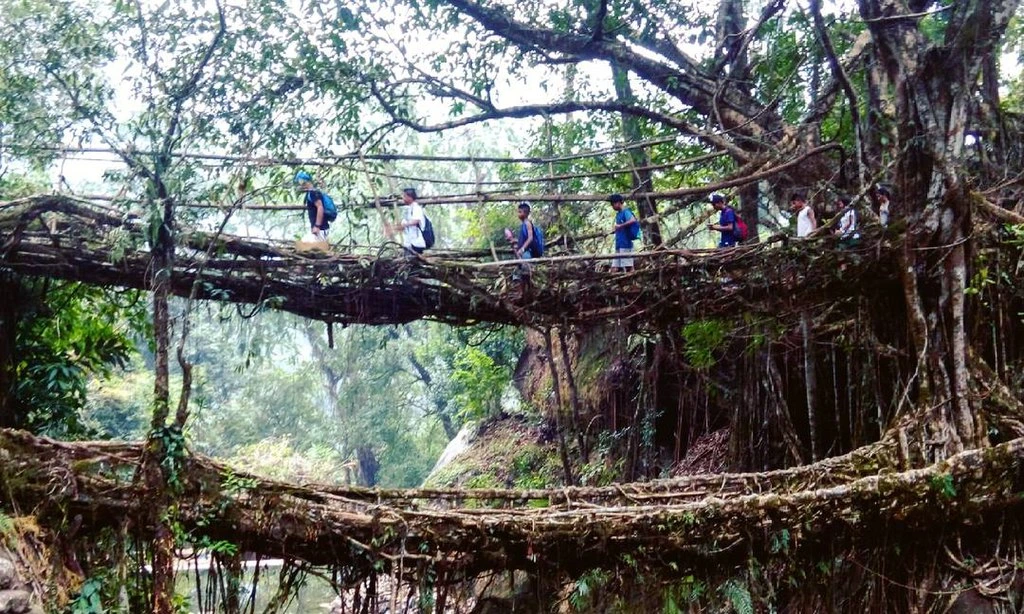
When I asked Jambor what makes these bridges so spectacular, he paused, running his hand along one of the roots. “It’s the way they bend, but never break,” he said. “They grow stronger with time, even in the toughest soil. And no matter how many people cross them, they’re never quite the same—they’re always changing, always adapting.”
Jambor’s words stayed with me as I explored the incredible features that make these living root bridges truly extraordinary. Beyond their visual beauty, they represent a unique harmony between nature and human ingenuity, designed to withstand the challenges of time and terrain. Here’s what makes these bridges so remarkable:
Elasticity and durability
Unlike modern, rigid structures, these bridges have a unique natural elasticity. The intertwining roots of the Ficus Elastica tree flex and adapt to varying weight and pressure, making them incredibly resilient. This elasticity allows them to withstand everything from the movement of the forest to the heavy foot traffic of villagers and travelers alike.
Vernacular architecture marvel
Living root bridges are created using a technique known as the “Baubotanik” approach, which involves manipulating the growth of trees as a natural building material. Unlike modern bridges, which rely on steel and concrete, living root bridges are built without the use of design tools or conventional materials.
A literal breathing structure
Beyond their functional role as bridges, living root bridges contribute significantly to their environment. These structures enhance slope stability and play a role in the ecosystem by producing their own building material on site—something modern bridges can’t do. They also absorb CO2 throughout their lifespan, making them a prime example of regenerative design.
Natural fusion of roots
The roots used in these bridges don’t just grow side by side—they naturally intertwine and fuse over time. This gradual process strengthens the bridge, creating a dense network of roots that continues to adapt and grow, making the structure even more secure and robust with each passing year.
Thriving in harsh soils
The Ficus Elastica trees used for these bridges are capable of growing in tough, rocky soils, which are common in the Khasi Hills. Their ability to thrive in such challenging environments is key to the stability and longevity of the bridges. These trees firmly anchor themselves into the ground, ensuring the bridge can withstand the rough terrain and unpredictable weather of the region.
Strength to support heavy loads
Despite their organic origins, these bridges are remarkably strong. A single living root bridge can support more than 50 people at a time, proving their practicality for daily use in the village. As the roots continue to grow and fuse, the bridge only becomes stronger with time, showcasing the sustainable genius behind these natural structures.
Rooted in tradition, growing for the future
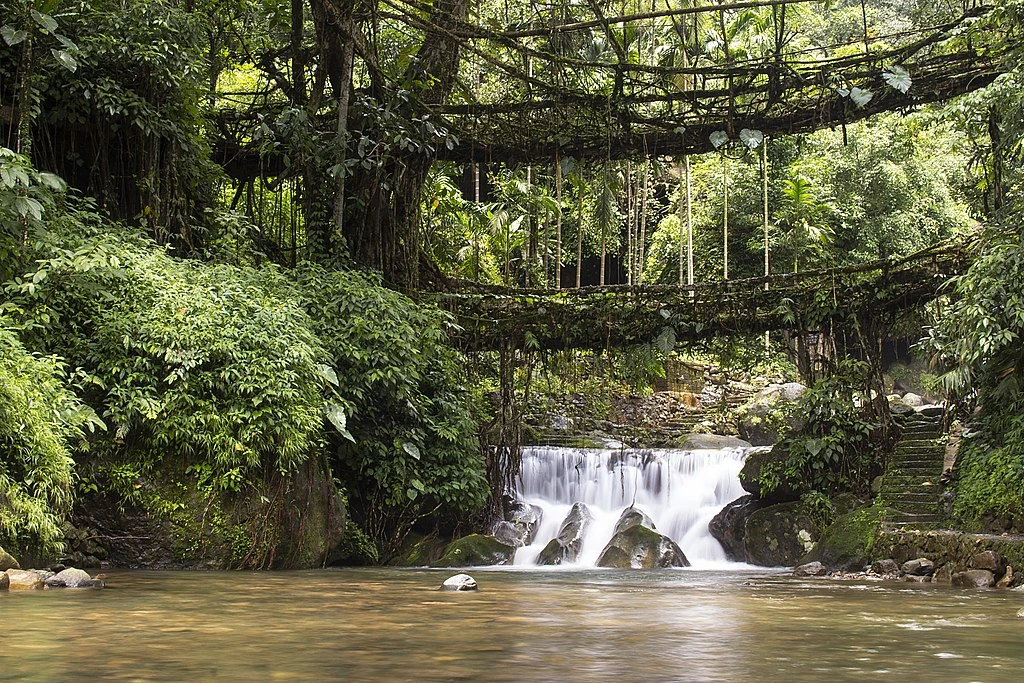
As we Jambor served a delicious plate of the monsoon favourite ‘Jadoh snam,’ which is cooked in pork blood, he told me that the most important lesson he learned from his grandfather was the art of patience. Year after year, he watched the roots grow bigger and stronger, as he himself grew from a small child to a young man. Jambor understood how the diengjri—as the Khasi call the ficus elastica—was growing on a different timeline than his own. Even though its growth was slow, it would outlast his own life. “My grandfather would say, ‘We grow with the tree, but the tree grows beyond us. Its roots are not just for us, but for those who will walk here long after we are gone,’” Jambor recalled.
His words highlighted the forward-thinking nature of the Khasi people’s relationship with their environment. More than just functional, the living root bridges reflect their culture revolves around respecting nature’s delicate balance. Over the years, the root structures grow stronger, no longer needing bamboo support to bear significant weight. Because they’re made of living, growing organisms, living root bridges have a variable lifespan. Once fully grown, these bridges can last for about 500 years or even more. The bridge will naturally self-renew and self-strengthen as long as it comes from a healthy tree. Despite some roots decaying due to continuous exposure to water, others grow thick and long, compensating for the decay. The Khasi people, like their ancestors, continue to cultivate these living wonders, ensuring they remain a vital part of the landscape for generations to come.
Preserving a living legacy – UNESCO recognition and the future of root bridges
Recognizing the cultural and ecological importance of these bridges, India submitted a proposal in 2022 for their inclusion as UNESCO World Heritage sites. This designation aims to protect over 72 living root bridges and other similar structures across Meghalaya. Each living root bridge is described as a “distinct ethnobotanical journey rooted in profound culture-nature reciprocity,” symbolizing the harmonious relationship between humans and plants.
These bridges are a remarkable breakthrough in nature-based design and engineering, not only contributing to human needs but also promoting forest and riparian restoration. Jambor shared his hope for the future, “It’s not just about keeping the tradition alive. It’s about keeping these bridges alive, for the land, for the people, and the future.”
Tips for exploring Meghalaya’s Living Root Bridges
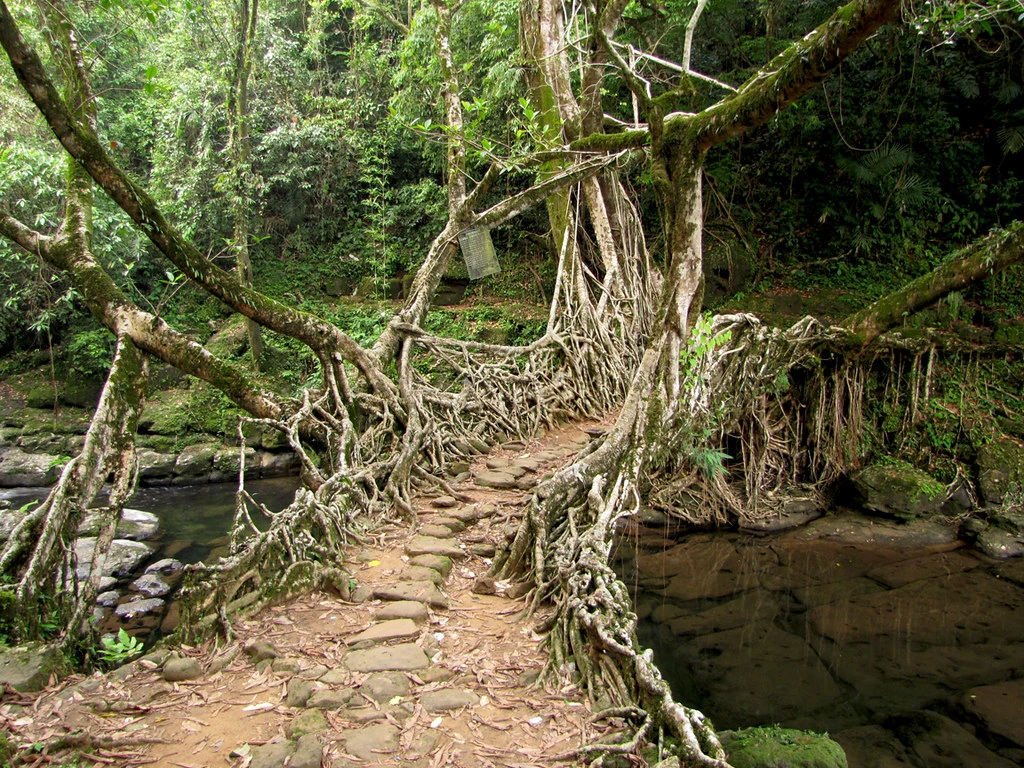
Exploring the living root bridges of Meghalaya is one of the most memorable adventures I’ve had, offering a unique glimpse into nature’s craftsmanship and the ingenuity of the local tribes. From the living root bridge in Mawlynnong to the one in Dawki, here are my personal tips to help you make the most of your journey.
Plan your route
Before hitting the road, I made sure to plan my route carefully. The living root bridges are scattered across various locations, including Cherrapunji, Mawlynnong, and Dawki. For example, when I visited the Living Root Bridge in Cherrapunji, I started my trek from Tyrna village—it took about 3-4 hours of downhill hiking. If you’re heading to the Living Root Bridge in Mawlynnong, the walk from the village is much easier. You can also plan your trip with flexibility to include other marvels, such as the Krem Chympe caves, India’s hidden river cave, and more.
Hire a local guide
To get the full experience, I highly recommend hiring a local guide. They can offer fascinating insights into the history and cultural importance of the bridges, and believe me, it makes the journey all the more enriching. Whether you’re visiting the Living Root Bridge or one of the double-decker living root bridges, a guide will help you navigate the rugged terrain and share stories that bring the bridges to life.
Wear proper footwear
This is key! The trek to many of these bridges, especially during the rainy season, can be slippery and challenging. I made sure to wear sturdy shoes with good grip, and it made a huge difference when tackling the steep paths, especially on my way to the Dawki and Mawlynnong living root bridges.
Pack water and snacks
You’ll likely be trekking for a few hours, so be sure to carry plenty of water and some snacks. I found that having a quick bite on hand kept my energy up, especially when visiting more remote locations like the Shillong living root bridge or the bridge near Dawki.
Respect local customs
While these bridges are stunning architectural wonders, they also hold deep cultural and spiritual meaning for the local communities. I made a conscious effort to respect local customs, whether that meant following specific guidelines or simply being mindful of my behavior. Always be aware of the significance these structures hold for the people who live around them.
Prepare for the weather
Weather in Meghalaya is unpredictable, so always be prepared. When I visited during the monsoon season, having a rain jacket and being ready for sudden downpours was a lifesaver. Be mindful of how quickly the weather can change, especially when visiting more remote bridges like the one in Dawki.
Take photos responsibly
The bridges offer some fantastic photo opportunities, but it’s important to be respectful of the environment. I made sure to follow any photography guidelines and avoided damaging the area just to get a better shot. After all, preserving these bridges for future generations is just as important as capturing their beauty.
Check accessibility
Not all bridges are easy to reach, and some require a bit more trekking than others. For example, the living root bridge in Cherrapunji involved a lot of hiking. So before setting out, I always checked the trail conditions and accessibility. This helped me prepare and avoid any surprises.
By following these tips, you’ll be well-prepared for an incredible adventure. From Mawlynnong to Cherrapunji, each of these living root bridges offers a unique experience blending natural beauty and cultural heritage. Enjoy your journey and soak in the magic of these one-of-a-kind structures!
The endangered art of living root bridges – A race against time
The greatest threat to the survival of these remarkable structures isn’t human negligence, but the inevitable passage of time. The ancient art of weaving and maintaining living root bridges is slowly fading away. One of the main challenges is the time it takes for these bridges to become fully functional and safe. Unlike steel or concrete bridges, which can be constructed quickly, living root bridges require decades of growth and nurturing before they are ready for use.
“I remember my grandfather telling me, ‘The roots won’t hurry, and neither should we. They take time, just like anything that’s meant to last,’” Jambor shared. But in today’s fast-moving world, this patience is becoming harder to find. While steel and concrete bridges may be more expensive and lack the environmental benefits and longevity of living root bridges, they offer immediate functionality, making them more practical in many cases.
As a result, outside of tourist areas, villagers often don’t see the value in making such an intergenerational investment. Many have gradually abandoned the construction and upkeep of these natural structures altogether. However, in recent years, a growing number of individuals and organizations have recognized the importance of preserving this botanical architecture. Efforts are now being made to promote the propagation and conservation of the living root bridges, ensuring that this unique practice is not lost to time.
Discover Meghalaya’s Root Bridges – Nature, tradition, and exploration
Meghalaya is home to over a hundred living root bridges, each with its own unique beauty and story. From the steep inclines of Kongthong to the towering heights of Rangthylliang, these wonders of nature showcase the remarkable bond between the Khasi people and their environment. However, the rugged terrains can be challenging, especially for those unfamiliar with the region.
The best way to explore these remote and breathtaking locations is by downloading the Savaari app and booking a reliable car, where experienced chauffeurs will navigate difficult landscapes with ease. With Savaari, you can relax and enjoy the journey, trusting the expertise of local drivers who know the region well.
As you visit these bridges, remember that they are living structures, carefully nurtured for centuries. Just as the Khasi people have tended to them with care and patience, it’s essential that we do our part to ensure their preservation for future generations. Be mindful of the delicate balance these bridges represent, and treat them with the respect they deserve. After all, these remarkable structures are not just for us—they are a gift for those who will walk their paths long after we’re gone.
Last Updated on December 11, 2024 by V Subhadra


